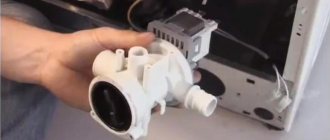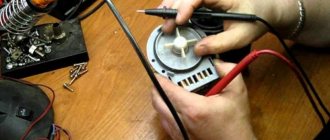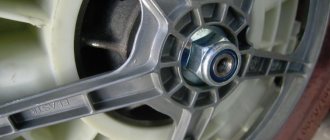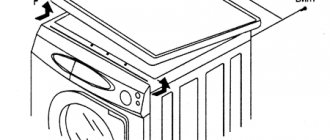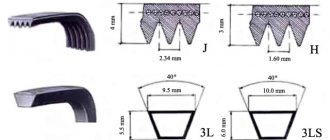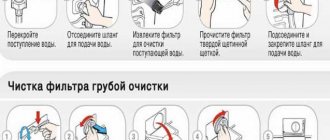How to replace the drain pump on a Bosch washing machine
What kind of breakdowns may require replacing the drain pump?
The drain pump in a Bosch washing machine is necessary to pump out water after washing. It is involved in every work cycle and wears out naturally. Problems with water drainage may indicate the need to install a new pump:
- error code on the display,
- the machine does not drain water,
- water remains in the tank after washing,
- The SM freezes in the middle of the cycle and does not complete the program.
Only an experienced Bosch washing machine repair technician can understand what exactly caused the failure, so we strongly do not recommend doing self-diagnosis, and we suggest treating the instructions only as informational material.
What to do before replacing the drain pump
- Make sure the drain hose is not clogged or kinked.
- Check to see if the filter is clogged.
- Clean the filter and hose, install the hose in the correct position and start the wash.
If the problem persists, most likely the drain pump is broken.
- Disconnect the machine from the water supply and electrical network.
- Drain off any remaining water.
Is the pump really broken?
How to understand that a malfunction of a Samsung washing machine is caused by a pump defect?
First, you should inspect the washing machine for other damage and check the functionality of other parts and elements. First of all, focus on the external signs of a malfunction. All modern machines notify the user of a breakdown by displaying an error code on the digital screen
By seeing the conventional combination of numbers and letters and deciphering it using the instructions for the device, you will understand whether the inoperability of the drain system is the root cause of the problem.
Start checking the system, first make sure that the spin function has been set by the program. If not, then enable this mode again. If nothing happens, check the drain hose; it should not be located above the level of the tank and have kinks. If it is level, disconnect it from the utilities and check for blockages. Direct the free end of the hose into the bathroom and turn on the automatic flush mode. If water begins to flow freely, then everything is fine with the machine, and the root cause of the breakdown is a clogged sewer pipe.
If the problem is not a blockage, you need to move on to the next step. Remove the protective panel (in some models, access to the elements of the drain system is opened by a small hatch) located below, on the front wall of the case. Prepare a container of such volume that all the water from the machine fits into the container, place it and unscrew the drain filter. Drain the liquid from the tank and remove any accumulated debris from the surface of the filter.
Using a flashlight, illuminate the hole in which the part stood. Carefully examine the impeller to see if it rotates freely. If the impeller stands still or moves with great force, it is worth starting to check the pump.
Replacing the pump in a Bosch washing machine step by step
Remove the top and rear panels of the CM housing using a hex screwdriver.
After this, you need to turn the machine on its side, but before that, fix the drum inside the washing machine. A piece of cardboard or something similar will do. Simply place it between the side panel of the body and the drum, so that when you turn it over, the drum does not come into contact with the panel (as in the picture). This will help avoid mechanical damage to internal components.
The machine may be heavy. Ask a friend for help to avoid injury.
This is what the drain pump looks like in a Bosch washing machine:
First of all, disconnect the wires, turn the pump counterclockwise and remove it. Here you may encounter a problem - on some models of Bosch washing machines there is a clamp that prevents you from removing the pump.
This clamp does not need to be removed. Use pliers to move it away from the pump. Then remove the pump. Be prepared for the possibility that a small amount of water will be spilled on you.
You can install the new drain pump into the seat by pressing it firmly and turning it clockwise. Don't forget to return the clamp to its original place, connect the wires and reassemble.
Good luck with the renovation!
Author of the translation: Elremont
Possible difficulties
When repairing a Bosch washing machine, you may encounter various difficulties:
| Problem | Ways to solve the problem |
| The screwdrivers provided do not fit the mounting screws. | You should take care in advance of a large set of screwdrivers and heads |
| The tank cannot be removed from the housing after disconnecting | You should check whether all fasteners have been disconnected, and whether the counterweights, which significantly weigh down the structure, have been removed. |
| After assembly and during the first start, a puddle appeared under the washer | To determine the location of the leak, the washing machine will have to be disassembled and diagnosed |
| Screws missing during installation | Screws lost due to carelessness can be replaced with similar ones. |
| Bearing cannot be removed | WD-40 can help remove stuck parts. |
| Some screws won't come out | |
| The new bearing does not fit the seat | It is likely that the bearing you purchased does not fit your existing washing machine model. |
How to call a specialist
To call a home appliance repair specialist:
- Call: in Moscow4
- in St. Petersburg
When contacting by phone please provide:
- Type of equipment, brand and, if possible, model;
- What exactly broke - describe in your own words;
- Indicate the date and time convenient for the repair;
- Contact information: phone number, address, full name, nearest metro station.
Call the master
Replacing bearings in a Bosch washing machine is a task that a beginner cannot handle.
If it is impossible to carry out repairs on your own, you should contact a household appliance repair company. Companies that have been providing support services for household washing equipment for several months now employ experienced craftsmen who can carry out high-quality repairs of any complexity.
The cost of work depends on the price list of the company and the type of repair. If other work needs to be done in addition to bearing replacement, the cost will be higher. On average in the capital, the price for replacing bearings in Bosch washing machines ranges from 4,000 rubles and more.
After the replacement has been carried out and the Bosch washing machine has been assembled, the technician performs a test run of the washing machine, after which a warranty is issued.
How to repair or replace the pump in a Bosch washing machine?
Performing the task of a primary assistant in household affairs, the washing machine turns into an indispensable household appliance. Its breakdown brings a lot of discomfort. The appearance of malfunction signals in the form of program failure during washing is mostly associated with the functioning of the drain system.
The pump in the washing unit may become clogged and must be cleaned as soon as possible. Otherwise, you will need to eliminate a more fundamental problem that it can lead to.
How to remove?
If during washing the display shows the error “pump is clogged,” then in order to clean it, it is necessary to dismantle it. We perform the following steps.
- Remove the top and back casing of the washing machine using a hex screwdriver.
- After this, you need to put the machine on its side, just first fix the drum inside the washing machine . A piece of cardboard or something similar will do. Let's just place it between the drum and the side panel of the case so that when turned over the drum does not come into contact with the panel. This will ensure against mechanical damage to internal elements.
- Now disconnect the electrical wires, turn the pump counterclockwise and remove it. There is a possibility of encountering a difficulty - some modifications of Bosch washing machines have a clamp that prevents the pump from being dismantled. There is no need to remove it. Use pliers to move it away from the pump. After this, remove the pump. Be prepared for the possibility that a small amount of liquid may spill on you.
How to clean?
The pump cleaning operation consists of the fact that you will need to very carefully clean one component of the pump - the impeller. To fully clean the impeller, it will also need to be removed.
The process of removing the impeller is simple: using a screwdriver, you need to remove the screws that connect the 2 parts of the pump. When these parts are separated, you will see a small head. This will be the impeller. During operation of the unit, this head rotates, due to which water is drained.
Clean it of dirt, wool fibers, hair, threads and other debris and wipe the inner snail of the element. At the end of the event, assemble the pump, install it in place, also assemble and properly secure the other removed elements. When the device is finally assembled, perform a test wash. If water is filled and drained in accordance with the norm, and no knocks or noises are heard when the device is operating, then you have done everything correctly.
Don't forget about the filter. Not every time the pump is the cause of a water drainage failure. The machine may refuse to drain water due to a clogged drain filter.
You can clean the washing machine pump filter while dismantling the pump, since when you get to this element, you will still be removing the filter plug. Simply immediately remove all debris and foreign objects from it, and then remove the pump itself.
Principle of operation
The principle of operation of the pump is simple. It comes into play after the wash is completed, pumping out and draining dirty water and detergent residues.
The part is represented by the following elements:
- a motor that consists of 2 parts: a rotor with a magnet and a starter with a core and winding;
- rotor shaft with bushing;
- impeller;
- frame;
- seal;
- inlet and outlet pipes.
Pump operating principle
- To be activated, the pump must receive a signal from the control module to which it is wired.
- After receiving the command, the impeller begins to rotate, pumping water from the tank into the sewer pipe.
- First, the liquid enters a rubber pipe, which is connected with clamps to the tank and the volute.
- Then, through the filter on the volute, the water flows onto the pump impeller. The role of the filter at this stage is very important, as it protects the part from small debris. If there was no filter, the impeller would jam after just a few wash cycles.
- The liquid then enters the drain hose and passes further: into the sewer pipe, bathtub or toilet.
- Pumping is carried out until all waste water is pumped out of the machine.
When there is no water left in the tank, the pressure switch will send a signal to the electronic module, and it will command the pump to stop working.
How and what to replace?
Replacing pumps in Bosch washing units differs from rotating drain pumps in Samsung or LG washing machines only by removing it. And in particular - not through the lower part, but by dismantling the front wall.
So let's get started.
- First of all , you need to disconnect the unit from the electrical network, unscrew the pump filter and empty the drain system of liquid. Then we take a screwdriver, find a clamp under the o-ring seal of the hatch (an iron ring with a spring must be installed), hook it up and carefully dismantle it.
- After removing the clamp, disconnect the O-ring, and so that it does not interfere, you can push it into the tank . Now you need to dismantle the upper part by unscrewing 2 screws on the back of the case and push it back as far as possible.
- Press the center stop and pull out the detergent tray.
- Unscrew the screws from the control panel . It is fixed from above using latches. We dismantle it and put it aside (up), there is no need to disconnect the electrical wires.
- Under the open filter hatch of the drain system, you will find a screw that holds the lower casing. We turn it inside out and move the plastic to the left side until it clicks. Then we dismantle the panel, and 2 screws securing the front wall become available to us.
- After unscrewing the screws, pull the front wall towards you and up, and disconnect it. We disconnect all electrical wires and connectors on the front panel, including the hatch locking device. We place the front wall to the side.
- Now you can proceed to dismantling the drainage device from the machine body. The first step is to remove the pipes from the volute by squeezing the clamp spring with pliers. First, the pipe extending from the drum is dismantled, and then the drain pipe.
- Disconnect the wires supplying power to the pump. Now you need to remove the screws holding the volute with the drain filter.
- We remove the pump with the volute from the machine body . Press the screwdriver onto the clamp and turn the pump relative to the volute until it separates. On a note! Before removing the snail, make marks using a marker so as not to forget the initial location of the disengaged elements for further error-free assembly.
- We connect the new pump and snail together. You can install a new drain pump into the seat by pressing firmly on it and turning it in the clockwise direction. Do not forget to return the clamp to its place, connect the electrical wiring and carry out the reverse assembly.
Immediately after you put the pump in place and connect all the pipes, test the connections for leaks. To do this, pour some water into the drum. If the joints are tight, you can continue assembly work. This completes the repair.
Remember! When rotating a drain pump, it is necessary to select an absolute analogue in design and technical characteristics. All drain pumps differ both in power and productivity, and in the method of fixation. You must choose only from reliable and reputable manufacturers.
To learn how to replace the drain pump in a Bosch washing machine, see below.
How to change?
Replacing the rubber seal on the hatch door of a Bosch washing machine consists of three main stages: dismantling the old cuff, installing a new seal, and reassembling the washing machine.
How to remove?
To quickly get to the desired element - a worn cuff, you need to carry out a series of sequential actions:
- Using a Phillips screwdriver, unscrew the fasteners holding the top panel of the washing machine.
- Gently pushing forward, remove the cover from the washer body.
- Remove the detergent dispenser. To do this, you need to press a special latch inside the tray, after which the powder receptacle is very easily pulled out of the grooves.
- In the opened niche of the detergent dispenser, unscrew the fasteners holding the control panel. Carefully, trying not to damage the wiring contacts, remove the panel from the washing machine body.
- Using a flathead screwdriver, press out the latches holding the decorative panel located at the bottom of the washing machine.
- Open the hatch door of the washing machine. Feeling the edge of the rubber seal with your fingers, find the retaining clamp (thin metal ring).
- Using a flat-head screwdriver, carefully pry the clamp off the cuff.
- Place the rubber seal into the washing machine drum.
- Unscrew the fasteners holding the hatch lock device (located on the right side of the loading hatch), disconnect the UBL wiring.
- Unscrew the fasteners around the perimeter of the front panel and remove it from the washing machine body.
- Using a flat screwdriver, carefully pry off the second clamp (metal ring) together with the rubber seal.
On the cuff, in the upper part, the manufacturer provides a special mark, which must coincide with the mark on the tank.
If there are no additional marks, before dismantling the old cuff, the point of contact of the tank with the rubber seal must be marked with a marker. This will help avoid mistakes when installing a new cuff.
Installation of a new part
Installing a new rubber hatch door seal yourself will not be difficult, provided you follow a clear sequence of actions:
- carefully inspect the new part, turn the rubber with the drain holes down;
- lubricate the grooves of the cuff and the seat with a soap solution (sliding simplifies the process of tightening the rubber seal);
- placing the cuff in a special recess located along the edge, evenly stretch the rubber seal to the right and left sides, pulling it onto the seat;
- secure the new cuff with a metal clamp.
It is necessary to ensure that the drain holes are located clearly in the center, otherwise problems with draining water may occur.
Reassembly
The process of reassembling a Bosch washing machine occurs in the following order:
- The UBL contacts are connected.
- The front panel is attached to its original place.
- The hatch locking device is secured with fasteners.
- The rubber cuff is fixed with a metal clamp.
- The lower decorative panel returns to its original place.
- The control panel is attached, the lid is mounted, and the detergent dispenser is inserted.
The reassembly process is completed, the washing machine is connected to the communications, after which a test wash is started.
How to change cuffs - in the video:
Replacing the drain pump (pump) on the BOSCH Maxx 4 WFC 1600 washing machine
Something fell apart a couple of months ago, such a wonderful BOSCH Maxx 4 washing machine (photo below), which served faithfully for about 15 years. Probably this glamorous inscription “Made in Germany” on the face, placed in those distant times, still means something, because the current tribe of household appliances is stamped with allowance for fading in a year or two (I think so

